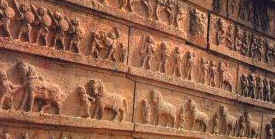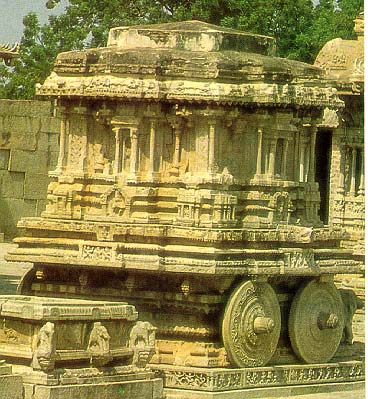The most splendid of temples at Vijayanagar is the Vitthala
temple, near the Tungabhadra river. It is considered to be the most ornate of the
Vijayanagar temples.
Hampi, now in ruins is the site of
the ancient city of Vijayanagar, capital of the Vijayanagar empire (founded under the
spiritual guidance of Vidyaranya of Sringeri
in early 14th century) ) which brought about a renaissance of indigenous art and culture,
as it defended the region against the plundering armies from elsewhere.

Much of Vijayanagar is now in ruins, as when the
rulers were defeated at the hands of the invaders at the battle of Talikota
in the 16th century, most of the marvelous structures and edifices were systematically
destroyed.
Vitthala - Vishnu is enshrined in
this temple. The mahamandapam of this temple, in front of the sanctum - enclosed in
the inner courtyard is of great beauty. It's base is chiseled with friezes of the swan,
the horse and the warrior. At intervals, there are projections with bas reliefs portraying
the deification of the ten avataras of Vishnu.

The steps on the east of the mahamandapam are flanked
by an elephant balustrade. The facades are lined with forty pillars, each over 10 feet in
height. Each group of pillars has a central pillar with slender shafts around. The center
of the Mahamandapam has sixteen pillars decorated with Narasimha and Yali,
forming a rectangular court. The ceiling of the Mahamandapam is also covered with
sculptural work.

The stone chariot in this temple is
of great fame. Its stone wheels, each shaped in the form of a lotus, are capable of
revolving. It represents the sprakling creativity of the artistes of the fifteenth
century. Temple chariots are often mobile reproductions of a temple. The stone chariot
here is in turn a static version of the mobile temple chariot.
See Also:
Virupaksha Temple at Hampi
Simhachalam (Stone Chariot)
